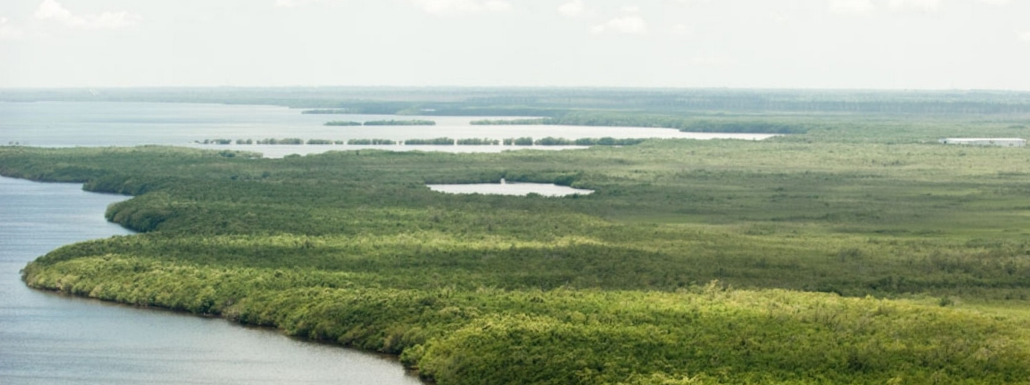Moving Miami-Dade’s Urban Development Boundary Could Jeopardize Work To Restore Water Flow To Biscayne Bay
Late last year, just before Miami-Dade County Commissioners made the controversial decision to move the urban boundary that protects wetlands and farms to make way for a warehouse complex in South Dade, former chairman Jose ‘Pepe’ Diaz lectured opponents at the crowded commission chambers.
“It is not environmentally sensitive land,” he said. “What is important is that the people are not misled. Because if it was environmentally sensitive land, none of us could go into it.”
But even planning officials say the area is, in fact, among the most sensitive, long seen as a key link to restoring the Everglades and fending off sea rise.
The nearly 400-acre warehouse project, scaled back from an original complex more than twice the size, would be built over an old slough — a shallow, slow-moving channel found in wetlands — that once carried freshwater from the Everglades to Biscayne Bay.
It sits at what Hold the Line Coalition representative Laura Reynolds calls the “bottle neck” for restoring water flow. That’s part of the reason it drew such widespread opposition — from federal, state and county agencies, the Miccosukee Tribe, farmers and nearby municipalities.
“It was the piece of the sawgrass, the river of grass, that connected that area of Everglades National Park with Biscayne Bay,” said Miami-Dade water resources chief Craig Grossenbacher.
The sloughs could also play a critical role as climate change makes managing water, both floodwater and saltwater intrusion threatening drinking water supplies, more complicated in South Florida.
“These are the low-hanging fruit,” Grossenbacher said. “I’m not trying to minimize the challenges, but these are the no-brainer areas that need to be restored.”
The decision to move the boundary is being challenged by a nearby resident Nita Lewis, who is represented by the Everglades Law Center. A hearing before an administrative law judge is scheduled for May in Miami.
Seven miles to the north, another old slough near the Deering Estate has been restored as a flow-way that’s now helping revive the freshwater sheetflow that could help the ailing bay. It will become part of the larger Corps project that was included in the Comprehensive Everglades Restoration Plan passed by Congress in 2000 and, like others, being revised to deal with changing conditions.
Straddling Old Cutler Road, it’s easy to miss the barrel-tiled pump house erected nearly a decade ago. To the west, a young hardwood hammock planted by county staff is starting to mature.
“We got pigeon plum, stoppers, marlberry. This is a really important plant for native pollinators and a couple of different butterflies,” Grossenbacher said.
A trail through the hammock leads to what was once part of the slough and has now been scraped down to a deeper wetland to hold freshwater. “You can see where we’re coming down from the rock ridge into the lower area of the natural slough,” Grossenbacher said as he led the way.
Before pioneers and canals, sloughs carried freshwater
Before South Florida was ditched and dredged by early pioneers and later carved into the regional and local canals that now drain the landscape, the sloughs cut through the high rock ridge in South Dade.
They carried massive amounts of freshwater during the rainy season that fed coastal sawgrass marshes, called transverse glades, and helped grow towering stands of mangroves. The seasonal deluges helped maintain carpets of seagrass and beds of oysters that anchored the bay bottom to create the famed gin clear waters.
“The bay in the early 1900s was a very thriving, productive coastal estuary. And the west side of it where we are, was mainly freshwater in the wet season.” Grossenbacher said. “It wasn’t saltwater as we know it to be now.”
So much freshwater flowed into Biscayne Bay that it bubbled up through springs on the bay bottom.
“In fact, there are several here that have now started to flow again since we’ve constructed this pump station,” he said. “Freshwater was the lifeblood of Biscayne Bay, and clean freshwater, lots of it, is what we need to restore the bay.”
Along with the sprawling restoration plan, the Corps has also launched a study of the southern end of the massive Central and South Florida canal system which can no longer keep up with flood waters driven by run-off and sea rise in parts of Miami-Dade, Broward and Palm Beach counties. A third plan, called the Back Bay plan, is underway to make the bay’s western shoreline more resilient to increasingly dangerous hurricane storm surges.
Those overlapping efforts highlight the urgency to deal with the increasingly complicated job of managing water in South Florida as both development, and now sea rise, continue to gobble up land.
Source: WLRN



